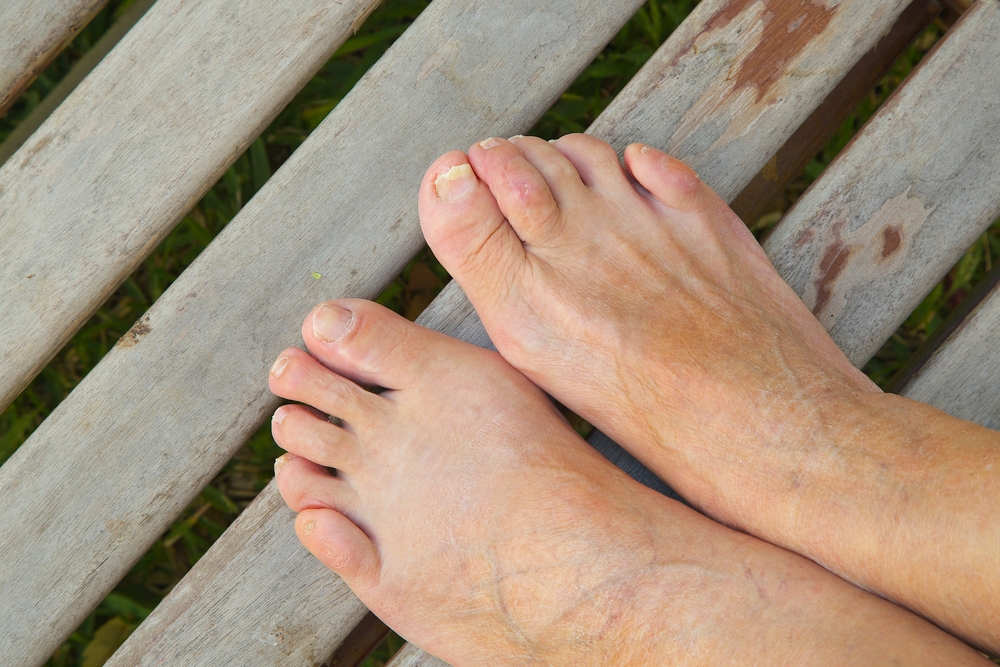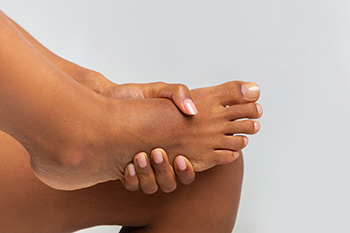Items filtered by date: August 2025
Causes of Hammertoe

Hammertoe is a deformity where the toe bends downward at the middle joint, resembling a hammer. It often affects the second, third, or fourth toe. Common causes include unusually long toe bones, muscle imbalances, rheumatoid arthritis, and foot injuries. Among other causes are bunions pushing against the toe, years of wearing tight or ill-fitting shoes, and genetic factors. Symptoms include pain while wearing shoes, visible bending of the toe, corns or calluses from friction, inflammation, redness, and restricted movement. The toe may appear raised at the joint and feel stiff or sore, especially during walking or pressure. A podiatrist can diagnose hammertoe with a physical exam and imaging, if needed. Treatment options include wearing roomier shoes, using custom orthotics, toe splints or pads, and prescribing anti-inflammatory medication. In more advanced cases, surgical correction may be recommended. If you have developed this condition, it is suggested that schedule an appointment with a podiatrist for appropriate treatment solutions.
Hammertoe
Hammertoes can be a painful condition to live with. For more information, contact Derek Smith, DPM from Oklahoma. Our doctor will answer any of your foot- and ankle-related questions.
Hammertoe is a foot deformity that affects the joints of the second, third, fourth, or fifth toes of your feet. It is a painful foot condition in which these toes curl and arch up, which can often lead to pain when wearing footwear.
Symptoms
- Pain in the affected toes
- Development of corns or calluses due to friction
- Inflammation
- Redness
- Contracture of the toes
Causes
Genetics – People who are genetically predisposed to hammertoe are often more susceptible
Arthritis – Because arthritis affects the joints in your toes, further deformities stemming from arthritis can occur
Trauma – Direct trauma to the toes could potentially lead to hammertoe
Ill-fitting shoes – Undue pressure on the front of the toes from ill-fitting shoes can potentially lead to the development of hammertoe
Treatment
Orthotics – Custom made inserts can be used to help relieve pressure placed on the toes and therefore relieve some of the pain associated with it
Medications – Oral medications such as anti-inflammatories or NSAIDs could be used to treat the pain and inflammation hammertoes causes. Injections of corticosteroids are also sometimes used
Surgery – In more severe cases where the hammertoes have become more rigid, foot surgery is a potential option
If you have any questions please contact our offices located in Ponca City, and Stillwater, OK . We offer the newest diagnostic and treatment technologies for all your foot and ankle needs.
Explaining Sinus Tarsi Syndrome

Sinus-tarsi syndrome is a painful condition that involves the tunnel between the talus and calcaneus bones in the foot. This space, known as the sinus tarsi tunnel, contains ligaments and tissues that help control foot stability and movement. Injury from an ankle sprain or repeated strain may damage these ligaments, causing inflammation, instability, and buildup of scar tissue inside the sinus tarsi. People with flat or over-pronated feet may also develop this problem due to pressure that forces the talus and calcaneus closer together. Common signs include pain on the front outer side of the ankle and a sense of weakness or instability, especially while walking on uneven surfaces. A podiatrist can help by performing a thorough foot and ankle exam, ordering imaging tests, and recommending treatment that may include surgery, if necessary. If you have symptoms of sinus-tarsi syndrome, it is suggested that you schedule an appointment with a podiatrist for an exam and appropriate treatment options.
Foot Pain
Foot pain can be extremely painful and debilitating. If you have a foot pain, consult with Derek Smith, DPM from Oklahoma. Our doctor will assess your condition and provide you with quality foot and ankle treatment.
Causes
Foot pain is a very broad condition that could be caused by one or more ailments. The most common include:
- Bunions
- Hammertoes
- Plantar Fasciitis
- Bone Spurs
- Corns
- Tarsal Tunnel Syndrome
- Ingrown Toenails
- Arthritis (such as Gout, Rheumatoid, and Osteoarthritis)
- Flat Feet
- Injury (from stress fractures, broken toe, foot, ankle, Achilles tendon ruptures, and sprains)
- And more
Diagnosis
To figure out the cause of foot pain, podiatrists utilize several different methods. This can range from simple visual inspections and sensation tests to X-rays and MRI scans. Prior medical history, family medical history, and any recent physical traumatic events will all be taken into consideration for a proper diagnosis.
Treatment
Treatment depends upon the cause of the foot pain. Whether it is resting, staying off the foot, or having surgery; podiatrists have a number of treatment options available for foot pain.
If you have any questions, please feel free to contact our offices located in Ponca City, and Stillwater, OK . We offer the newest diagnostic and treatment technologies for all your foot care needs.
